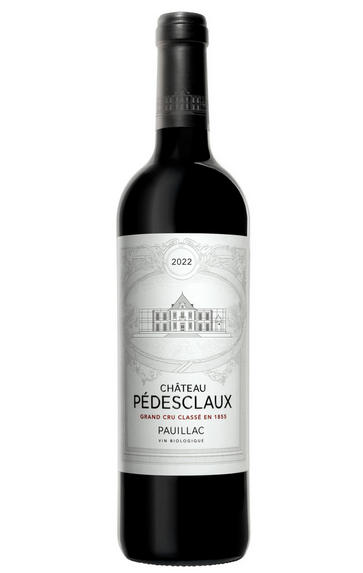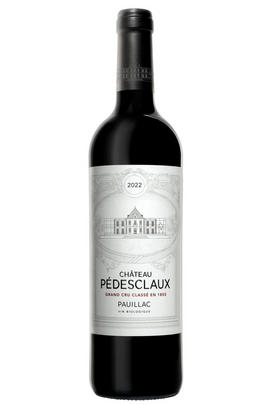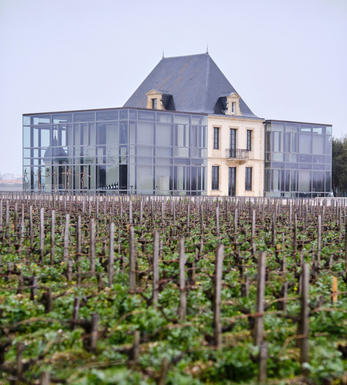
2022 Château Pédesclaux, Pauillac, Bordeaux

Critics reviews
Rich plum colour, vibrant edging, sleek and balanced, this is full of pleasure and precision. Generous in that you can feel the exoticism of the vintage in its ripe berry fruits but it has balance and the slate and liquorice character of Pauillac. 3.86ph, 37hl/h yield. 56% 1st wine in this vintage, first year organic certified (and the first classified estate to write this on the front label). Vincent Bache-Gabrielsen director. 65% new oak.
Drink 2027 - 2040
Jane Anson, JaneAnson.com (May 2023)
68% Cabernet Sauvignon, 22% Merlot, 7% Cabernet Franc, 3% Petit Verdot. Certified organic. Cask sample. Lighter than the top growths but pure and precise. Deep colour, dark-fruit fragrance and well-worked tannins. Freshness as well and some length on the finish. 14.4%.
Drink 2028 - 2040
Jancis Robinson MW, JancisRobinson.com (May 2023)
Now certified organic, the 2022 Pedésclaux exhibits aromas of dark berries, plums and pencil shavings, followed by a medium to full-bodied, suave and refined palate that's a touch lean on the finish. As it fleshes out with élevage, it should come into better balance.
William Kelley, Wine Advocate (April 2023)
The pure cabernet character clearly comes through with blackcurrants, blueberries, and flowers such as lavender and sandalwood. Medium- to full-bodied. Racy and polished tannins and a long, flavorful finish. 68% cabernet sauvignon, 22% merlot, 7% cabernet franc and 3% petit verdot.
From organically grown grapes.
James Suckling, JamesSuckling.com (April 2023)
Fruity and open on the nose. Nice intensity and structure, lively and straight In the mouth with overall balance. A touch light but so easy to drink with a real Cabernet signature. Feels well worked, not massively layered but delivers an enjoyable glass of wine with cool freshness and refinement.
Total acidity: 3.6. 35% new oak barrels. 3.79pH.
Drink 2026 - 2038
Georgina Hindle, Decanter.com (April 2023)
The 2022 Château Pédesclaux is a beautiful wine with an almost bloody, iron-like character in its cassis and blue fruits and notes of leafy herbs. It's medium to full-bodied, has a layered, silky texture, and terrific purity.
Jeb Dunnuck, JebDunnuck.com (May 2023)
About this WINE

Chateau Pedesclaux
One of Pauillac’s less well-known estates, Ch. Pédesclaux is well situated in front of Mouton Rothschild and Pontet-Canet. The property’s history dates back to the early 19th century when Urbain Pédesclaux – a renowned trader on the Bordeaux marketplace – acquired some vineyards put up for sale following the Revolution and established the estate in 1810. Symbolising the bourgeoisie’s arrival in the Médoc (previously under aristocratic rule), Urbain Pierre Pédesclaux set about building the estate’s reputation. When the wines of the region were classified in 1855, Ch. Pédesclaux was granted the title of Fifth Growth.
The estate was acquired by Françoise and Jacky Lorenzetti in 2009. Over the next few years they purchased new parcels, almost doubling the property’s footprint from 26 to 50 hectares. The vineyards underwent significant work with soil studies and replanting, and in 2014, Ch. Pédesclaux opened a new chapter, its vineyards fully restructured and an impressive new gravity-fed winery and cellaring facilities.

Pauillac
Pauillac is the aristocrat of the Médoc boasting boasting 75 percent of the region’s First Growths and with Grand Cru Classés representing 84 percent of Pauillac's production.
For a small town, surrounded by so many familiar and regal names, Pauillac imparts a slightly seedy impression. There are no grand hotels or restaurants – with the honourable exception of the establishments owned by Jean-Michel Cazes – rather a small port and yacht harbour, and a dominant petrochemical plant.
Yet outside the town, , there is arguably the greatest concentration of fabulous vineyards throughout all Bordeaux, including three of the five First Growths. Bordering St Estèphe to the north and St Julien to the south, Pauillac has fine, deep gravel soils with important iron and marl deposits, and a subtle, softly-rolling landscape, cut by a series of small streams running into the Gironde. The vineyards are located on two gravel-rich plateaux, one to the northwest of the town of Pauillac and the other to the south, with the vines reaching a greater depth than anywhere else in the Médoc.
Pauillac's first growths each have their own unique characteristics; Lafite Rothschild, tucked in the northern part of Pauillac on the St Estèphe border, produces Pauillac's most aromatically complex and subtly-flavoured wine. Mouton Rothschild's vineyards lie on a well-drained gravel ridge and - with its high percentage of Cabernet Sauvignon - can produce (in its best years) Pauillac's most decadently rich, fleshy and exotic wine.
Latour, arguably Bordeaux's most consistent First Growth, is located in southern Pauillac next to St Julien. Its soil is gravel-rich with superb drainage, and Latour's vines penetrate as far as five metres into the soil. It produces perhaps the most long-lived wines of the Médoc.
Recommended Châteaux
Ch. Lafite-Rothschild, Ch. Latour, Ch. Mouton-Rothschild, Ch. Pichon-Longueville Baron, Ch. Pichon Longueville Comtesse de Lalande, Ch. Lynch-Bages, Ch. Grand-Puy-Lacoste, Ch, Pontet-Canet, Les Forts de Latour, Ch. Haut-Batailley, Ch. Batailley, Ch. Haut-Bages Libéral.

Cabernet Sauvignon Blend
Cabernet Sauvignon lends itself particularly well in blends with Merlot. This is actually the archetypal Bordeaux blend, though in different proportions in the sub-regions and sometimes topped up with Cabernet Franc, Malbec, and Petit Verdot.
In the Médoc and Graves the percentage of Cabernet Sauvignon in the blend can range from 95% (Mouton-Rothschild) to as low as 40%. It is particularly suited to the dry, warm, free- draining, gravel-rich soils and is responsible for the redolent cassis characteristics as well as the depth of colour, tannic structure and pronounced acidity of Médoc wines. However 100% Cabernet Sauvignon wines can be slightly hollow-tasting in the middle palate and Merlot with its generous, fleshy fruit flavours acts as a perfect foil by filling in this cavity.
In St-Emilion and Pomerol, the blends are Merlot dominated as Cabernet Sauvignon can struggle to ripen there - when it is included, it adds structure and body to the wine. Sassicaia is the most famous Bordeaux blend in Italy and has spawned many imitations, whereby the blend is now firmly established in the New World and particularly in California and Australia.


Buying options
Add to wishlist
Description
There is plenty to enjoy at Pédesclaux, which has been a labour of love for the Lorenzetti family since 2009. The 2022 vintage was certified organic; this will be the first Classified Growth to print its certified status on the label.
There is much attention to soil health, focusing on mycorrhizal activity. Pédesclaux leans towards a polished style of wine; many of the more extreme expressions of 2022 are well-managed. The wine has plenty of ripe plum notes and summer pudding fruits. The palate is smooth and well-integrated.
Cabernet Sauvignon 68%; Merlot 22%; Cabernet Franc 7%; Petit Verdot 3%
Drink 2027 - 2042
Score: 16/20
Berry Bros. & Rudd (April 2023)
wine at a glance
Delivery and quality guarantee